We awoke, refreshed, after a long sleep and slipped out of the hotel before any of the other residents were awake to walk along the deserted beach. Even at 6am the water was warm and inviting and we let the sea wash over our bare feet, such a pleasant sensation, as we wandered along. A single Whimbrel flew away before us, its familiar tittering alarm call coming to us from along the beach. We were totally alone on a beach of the softest white sand, overhung by the occasional palm tree and the sea was a gentle blue.
As is usual in the tropics the sun was already well up and it would not be long before the heat and humidity would gather strength as we realised we were walking in a real life version of those impossibly inviting adverts you see on holiday brochures or in travel agent's windows.
A Ghost Crab scuttled away before us, running on tiptoe, its two eyes held on top of two periscopic appendages. It looked so comical and incongruous as it ran at incredible speed over the sand to dive down its hole in the sand only to then cautiously and partially emerge, to check what we were up to. Another crab, a Velvet Crab, slightly larger and darker scuttled into the detritus under the palms but did not retreat to a hole but faced us with one enormous club shaped claw dwarfing the other smaller one, almost as if saying 'Come on then if you fancy your chances'. We left it in peace.
We walked half a mile or so by the edge of the ocean and then retraced our steps to the hotel which was now waking up. Towels had already been spread to reserve sun loungers around the infinity pool although no one was in sight. We had to laugh at such silliness.
We walked straight from the beach to a buffet breakfast on the hotel patio and after breakfast it was time to get the bags packed and await the arrival of our Creole Travel courtesy car and driver which would take us back to the airport to catch our flight to Bird Island.
We duly arrived at the airport which really is tiny and even smaller is the domestic terminal, no more than a large room and hardly the most sophisticated in terms of facilities or comfort. Creole told us the domestic flights were delayed as two of the small aircraft used for inter island flights had technical problems so the flights were being apportioned accordingly amongst the remaining aircraft. The short inter island flights, ours was thirty minutes, are handled by ageing turbo prop aircraft that can take a maximum of fifteen or so passengers and clearly had seen better days.
Whilst we waited I took the opportunity to check out Perly's advice about the Seychelles Kestrels at the adjacent 'international' terminal. I walked the hundred metres to the terminal and there perched on the metal roof was a small bird hardly bigger than a thrush. Surely not? I looked in the bins and it was a Seychelles Kestrel, large as life. Such a pretty bird with its blue grey head and rich chestnut upperparts. I walked round to get a better angle for photography ignoring the curious looks from the ranks of taxis and their drivers and clicked way. The kestrel did not remain here long before diving off the roof and flying across the road into some trees. This was a splendid result and I returned suitably triumphant to my wife who was guarding the bags.
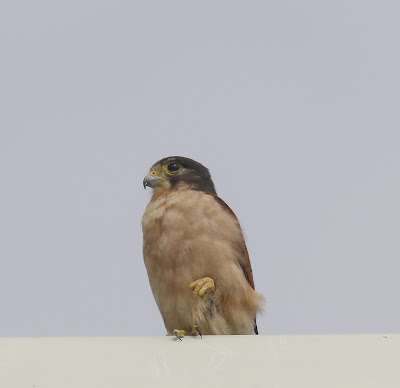 |
| Seychelles Kestrel |
We clambered into the tiny Twin Otter plane, the door closed and I watched through the open cockpit hatchway as the pilots prepared for take off, consulting a bewildering array of dials and instruments. With little ceremony we lined up on the runway and with an increased roar from the two engines as they were opened up, we made a short sprint down the runway and lifted up into the blue sky and Mahe receded below us.
The ocean below was a deep ultramarine betraying the depths we were passing over as we headed out north and thirty minutes later we circled over Bird Island, a coral island surrounded by waters of physchadelic electric blue inside the reef that encircles one half of the island and deep blue water beyond, where the reef drops into the abyss.
The plane, swaying from side to side came into land on the grass runway, straightening up at the last possible moment to make a perfect landing and then taxied back to where today's departing group of passengers from Bird Island were waiting in the shade. The door opened and we clambered out, assembled and were led to the central reception area by Robbie Bresson the Conservation Officer.
 |
| The Bird Island plane that lands once a day at around 1100am |
 |
| Map of Bird Island. The Chalets are marked in red |
Since 1967 it has been privately owned by the Savy family with the two brothers now running it as an eco resort and conservation measures have been put in place to protect the prolific birdlife and turtle nesting sites. Much of the island was covered with coconut trees but these were cleared to allow nesting birds such as the Sooty Terns to reclaim habitat and increase. Rats and rabbits have been eradicated and the Seychelles Sunbird has been successfully translocated to the island in 2006.
The island can accommodate only eighty people at one time and the open roofed chalets are situated in the centre of the tiny island in the former heart of the coconut plantation, where most of the trees have been removed but a few have been allowed to remain. Meals are served three times a day in the open air restaurant and there is a bar where visitors can congregate each night before dinner. If you desire luxury accommodation and all your needs attended to then maybe Bird Island, very much an eco lodge is not for you, as although comfortable its charms are simple and basic. Alex Savy one of the two brothers who inherited the island from their father says 'A client who accepts no air con is a client who accepts nature.'
However if you want to be in a place that is idyllic, where you feel the interloper amongst all the wildlife, enjoy pristine beaches, do not worry about lizards and geckos in your room, even the occasional bird, can survive for a few days without air conditioning, TV, mobile phones and wi-fi and just want to relax in your own space then this is most definitely for you.
 |
| The grass strip and trees running between the chalets and the beach some two hundred metres distant |
 |
| Brown Noddys by the runway |
The heat and humidity was intense but I could not wait to get started as birds were literally everywhere you looked. Our chalet, as with everyone else's had Brown Noddys perched on the verandah rail sheltering from the sun in the shade cast by our roof, the birds so confiding you had to move them out of the way. I sat with a cold drink on our verandah eyeing our very own courting pair of noddys no more than two feet from me on the verandah rail completely at ease with my presence.
Others formed little congregations in the full sun, spreading out a wing to flush out mites and parasites. There were many such groups scattered at random over the dry grass in front of the chalets
 |
| Brown Noddys |
 |
| Common Greenshank |
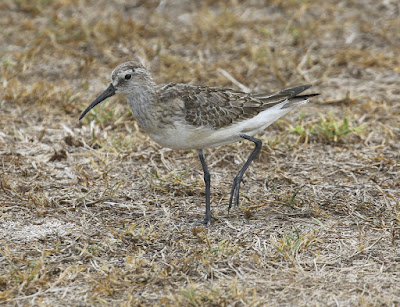 |
| Curlew Sandpiper Lesser Sandplover |
 |
| Sanderling |
We went for lunch and sat in the open wooden eating area and enjoyed a three course meal with copious amounts of fruit juice. Then it was back to the chalet with a thermos flask of iced water for a siesta until 4pm when Robbie was leading a nature walk and would be pointing out all things natural on the island.This we could not miss.
However I decided against a siesta and elected on the 'Mad Dogs and Englishmen' strategy and took camera and bins and headed for the north end of the island. Here is where, in the peak time from March to October an incredible 700,000 Sooty Terns nest and raise their young and even though we were at the end of October there were still getting on for a thousand or more Sooty Terns present, mainly young ones but with a good smattering of adults, some still feeding their full grown young.
 |
| Sooty Tern-adult |
I made my way back to the chalet and at 4pm we went with a few others to meet Robbie at the central reception area. He told us about the trees and plants that had colonised the island as seeds drifting on ocean currents, borne on the wind or brought by birds, and of much more interest to me told us how a lady who was not really a birder had found a small brown bird yesterday right by the restaurant and that she thought looked different to the abundant female Madagascar Fodys. It turned out to be a Red-headed Bunting, which was a first for The Seychelles. Five minutes later Robbie pointed to a small non descript bird with pale yellow flanks and brighter yellow undertail coverts hopping around in weeds behind the kitchen area. It was the bunting. Fantastic, a mega rarity and not only that but a lifer for me.
 |
| Black or Red headed Bunting-possibly a female |
 |
| Fairy Tern |
 |
| Young Fairy Tern on its perilous perch, that we saw on Robbie's walk |
We walked on and came across an Aldabra Giant Tortoise, of which there are twenty that roam the island with one, a male misleadingly called Esmeralda, being the largest in the world but he was in a different part of the island so would have to wait for another day before we could go and find him.
 |
| Aldabra Giant Tortoise |
 |
| Robbie (in white shirt) showing us the tropicbirds nest at the base of a tree |
 |
| White tailed Tropicbird-almost fully fledged juvenile |
 |
| White tailed Tropicbird-recently hatched youngster |
 |
| White tailed Tropicbird-adult |
 |
| Lesser Noddys |
 |
| Bridled Tern |
 |
| Brown Noddy |
A Seychelles Blue Pigeon, another endemic species was clambering around in a small Frangipani Tree. Although a pigeon it behaves more like a parrot walking along branches and twigs seeking fruit. Its appearance when seen close is spectacular with a livid red warty face, pale grey head and breast and wings of deep, glossed, midnight blue.
 |
| Seychelles Blue Pigeon |
We made our way back to the chalets and as we did I got talking to a British couple who told me how they had been sitting quietly by the beach and had seen a turtle come out of the sea right beside them and make its way up the beach to lay her eggs, after they had spent all last night unsuccessfully looking for one. I was deeply envious as this more than anything is what I wished to encounter but was learning that it was truly a matter of luck if you got to see such a thing and quite a number of people who visit the island are disappointed and fail to see any turtles.
We ended the day sat, overlooking West Beach and the spectacular sunset that ensued far out over the trackless Indian Ocean. The next land in the direction we were looking would be Somalia some 1500km away. As the sun set below the horizon the sky was ignited with a fiery afterglow as thousands of Brown Noddys came flying in from their pelagic wanderings to roost in the trees on the island and around the chalets. The noise from the terns was incredible and rose exponentially as more and more birds arrived for the night.
So to bed, tired but elated after an unbelievable day. What a truly magical place it has turned out to be. I lay on my bed and listened to the incredible noise of the countless roosting Brown Noddys, bickering and arguing all night long. Two or three were roosting on our verandah and when they called, which was frequently, it sounded like they were in the room. With no air conditioning but just a noisy fan, the heat and noise from the terns combined to make sleep very difficult so I just lay on the bed under the mosquito net and told myself that this experience was once in a lifetime so make the most of it. A pink House Gecko ran up the whitewashed wall and gave his stuttering call as the sweet scent of frangipani came on the night air and filled the room.
Frigatebirds
We rose with the dawn at 5.30 and were out and about by 6am and had the island to ourselves as no one else was stirring. I planned on going to the nearby frigatebird roosting trees to check on them and the boobies, just a five minute walk from our chalet. My wife preferred a walk on the beach so we agreed to meet back at the chalet at 8am before going for breakfast.
I assumed the frigatebirds would leave their roost at dawn but need not have worried as many remained in the trees until well into the morning whilst others did indeed head out to sea. I also assumed they would be wary but I forgot this is The Seychelles and I soon learned I could walk right up to them and they and the boobies took not one iota of notice of me. They sat on the thin branches of the tall trees and lazily preened their feathers or just sat indolently doing nothing. Others cruised around the trees effortlessly, flying on huge narrow wings and forked tails before clumsily landing once again in the trees much to the annoyance of those already perched there. Their bills were extraordinary, long, pink and substantial with a big bulbous, primitive looking hook at the end.
 |
| Frigatebird roosting tree |
 |
| Greater Frigatebird - female |
 |
| Immature Greater Frigatebird |
 |
| Adult male Lesser Frigatebird |
 |
| Adult female Greater Frigatebird |
 |
| Immature Red footed Boobies of various ages |
 |
| Adult Red footed Booby |
We saw the frigatebirds and boobies throughout our seven day stay on Bird Island, not only amassing to go to roost when the sight of them is so spectacular but also during the day when we often saw frigatebirds as they cruised around singly or in small groups. Looking out to sea in the early evening, occasionally you would see a group of them, black and white chasing an unfortunate Brown Noddy or Sooty Tern and looking for all the world like giant Pomarine Skuas chasing a Kittiwake.
Another memorable moment was standing alone in the early morning on the beach at North Point as a rain squall far out on the ocean created a huge rainbow and a lone frigatebird crossed its path.
I met my wife back at the chalet who told me that while I had been admiring the frigatebirds she had watched a turtle come out of the sea and up the beach she was walking on. She even had pictures on her phone! Ouch!
 |
| Hawksbill Turtle courtesy of Mrs U |
 |
| Barred Ground Doves cleaning up at breakfast |
Sooty Terns
As I mentioned Bird Island plays host to up to 700,000 of these birds but now at the end of their breeding cycle all but a thousand had departed but that was more than enough.They nest in and under bushes at the north end of the island so it was just a five minute walk to the colony. It is protected from unwitting incursions of unaware human visitors by extensive barriers of brushwood and signs but many of the terns choose to nest outside the main protected area anyway.
There were both adults and fully grown young scattered around on the grass, the young birds forming groups that sought shelter from the sun by hiding under the bushes in the shade. It was only when you got closer to the juvenile birds that you realised all was not well.The majority although looking healthy were incapable of flight as they were so weak from lack of food. They had literally been deserted by their parents and their fate was sealed as they would die a long and lingering death by starvation. Robbie told me many of the guests got upset at this but it was entirely natural at the end of the breeding season and there was nothing to do but let nature take its sometimes cruel course.
I watched a couple of adults displaying to one another totally ignoring the beseeching calls of presumably one of their juvenile progeny. So smart in their dark brown almost black and white livery, their calls are not too dissimilar to a Mediterranean Gull, although lighter and less yodelling in tone. They can be distinguished from far out to sea by their distinctive calls.
 |
| Juvenile Sooty Tern |
I walked along the edge of the colony most days and young birds, through weakness, teetered and flopped away from me along the ground and I stepped away to at least give them some peace in their final days. Other single birds wandered disconsolately over the dry grass or sand unaware that soon they would be dead and the crabs would come to feed on them. So paradise had another harsher edge after all.
Fairy Terns
These birds are the one's visitors find adorable as their whole demeanour and appearance is one of benign gentility. Snow white with large black eyes and a bill whose base is a deep ultramarine blue with matching legs and webbed feet, they fly like small angelic apparitions through the trees and around the island. Usually to be found in pairs, often indulging in synchronised courtship flights which involve flying incredibly close to each other, mirroring each and every move of their partner. Sometimes they are joined by a third interloper as they swoop and glide through and around the trees and bushes and sometimes far out over the ocean.
They do not nest colonially but each pair finds its own small branch on which to lay a single egg. You can spot them in the trees perched high up or lower down on bushes appearing as distinct white splashes amongst the pervading green.
 |
| Fairy Terns |
Red-headed Bunting
Found unknowingly by a non birder this was identified by Robbie and thus became the first for The Seychelles if it was a Red headed Bunting. It looks to me from the photos like an adult female in partial moult but as I have never seen one before I am circumspect about making a definite diagnosis. Also on reading up about this species I find that female Black headed Buntings can be virtually indistinguishable from Red-headed Buntings so until I can find someone more qualified to look at my images I have to go with Robbie's identification of which he seemed pretty convinced. I looked at the images I took and it would appear that the one diagnostic feature to distinguish female Red headed from female Black headed Bunting, namely the number of primaries visible beyond the tertials equalling four, looked to be evident on this bird.
The bunting was remarkably confiding but then virtually every bird in The Seychelles seems to be so and looking at blown up images there would appear to be no abrasion to the flight feathers or blunting of the claws which would indicate a possible formerly caged bird.
So a first for The Seychelles and a lifer for me. The bunting would put in sporadic appearances each day around the chalets and eating area feeding on black seeds it found on a low growing clover like plant called Bohavia that grew in profusion alongside the walls of the various buildings. Not the most charismatic and colourful of birds and most guests lost interest when they could see there was no sign of a red head. Not that this mattered to me!
North Point
This rapidly became our favourite area as it was near to our chalet at the northern end of the island and was generally devoid of any human presence as most guests would take the easier option of a walk of a couple of hundred metres to the beach opposite the chalets.
In the early morning I would walk down to North Point either along the sand and around the corner of the island disturbing the Ghost Crabs or past the Sooty Tern colony on the grass, inland of the beach.
 |
| Ghost Crabs |
Being such a lonely and beautiful spot we took to it immediately although by 8am it got very hot as the sun shone relentlessly on the sand but for the couple of hours prior it was magical with great stretches of white sand, the grains so fine they were almost like powder and a sea invariably showing differing shades of turquoise and that was forever warm and inviting. If you got too hot you just walked into the sea, felt the sand between your toes and cooled off in the tepid waters.
Relatively undisturbed it was also favoured by some very desirable birds. A flock of up to one hundred Saunder's Terns spent their time at the very tip. They are almost identical to Little Terns but can be told by the more extensive black colouring on the outer primaries. Tiny and petite, all in winter plumage they stood on the sand and by the white surf, ever alert, and would rise at the least provocation, flashing silver white in the sun before 'disappearing' as they tilted over to show their grey backs and then back to flicker white, like stardust against the blue ocean. They would soon settle and by careful stalking you could get relatively close to them. It was whilst stalking them that another small tern flew down, settled on the sand and revealed itself to be a White winged Black Tern - quite a pleasant surprise.
 |
| White winged Black Tern |
 |
| Saunder's Terns |
 |
| Greater Crested Terns |
 |
| Turtle Tracks |
 |
| Black winged Pratincole |
 |
| Greater Sandplover |
 |
| Crab Plover with Saunder's Terns |
 |
| Crab Plovers |
Turtles
I was getting increasingly frustrated at my lack of success in seeing a turtle. Both Hawksbill and Green Turtles nest on Bird Island but I had seen neither. Virtually every one I spoke to had enjoyed some encounter with a turtle and some were even blase about it and said they really did not worry if they saw one or not. Even my wife had seen one but for me fate was so far dealing a duff hand. I seemed to miss them by minutes or as happened on one occasion turned back when if I had walked just another hundred metres I would have found one. It is just luck I know but by the fourth day I was approaching breaking point.
 |
| Where is that turtle? |
So on the fourth day with high tide at just after 6am we made our way at 5.30am to North Point and found ourselves entirely alone on the wide expanse of sand, apart from the odd Crab Plover, until we were joined by a French couple, Philippe and Aurelie
 |
| This is the beach a Hawksbill Turtle came onto at around 8am |
 |
| Driftwood Sculpture |
I scanned constantly along the shimmering white stretches of sand but nothing untoward gave any reason for optimism. Bored we started looking for fish in the clear pale green waters at the point and found some Eagle Rays swimming along in formation. Philippe swam in to get a closer look but they disappeared to be replaced by a large shoal of silver grey fish swimming so close to the surface their dorsal fins stuck out of the water.
Tired of lugging around a heavy lens in the heat on previous days I had left it in the chalet bringing a lighter lens of my daughters. I took a photo and the lens promptly failed. Great, so no pictures, not that a turtle will turn up anyway.
We separated from Philippe and Aurelie and I went for some more Crab Plover action whilst the French couple sat and looked out to sea and my wife went looking for coral and shells. Time drifted on and we realised we really had to concede defeat as the heat from the sun was now getting uncomfortably strong.
'Oh well there is always tomorrow'.
We commenced our walk back to our chalet and looked one more time along the wide expanse of white sand that swept in a gentle concave curve to embrace a sea of exquisite turquoise and a gentle frill of white surf where sea met sand. Instead of the expected unsullied sand there was now a rounded olive green object on the shimmering white beach some 200 metres distant and just clear of the surf. It was wet and glistening in the sun and it had a head beautifully depicted with golden edged black squares and pentangles.
We both realised what it was at the same moment.
 |
| Crab Plover tracks |
We both realised what it was at the same moment.
Turtle!!!!
I shouted to Philippe and Aurelie who came running and we approached what turned out to be a Hawksbill Turtle. Remembering what Robbie had told us we ensured we only approached it from behind as then they cannot see you. Approach suddenly from the side and you can easily spook them and they head back for the sea which is the last thing anyone wanted as this critically endangered turtle has enough to contend with already.
It was only then I realised I had no camera or at least a lens that worked. Typical! I had no choice. I just had to go back for the big lens, so imploring my wife to keep an eye on the turtle I ran up the sand which is easier said than done, carefully avoiding a group of doomed juvenile Sooty Terns, and headed at some pace for the chalet. The increased temperature and humidity away from the sea was a nightmare but I ran as much and as fast as I could. Fifteen minutes should get me there and then fifteen minutes back. My throat was dry with inhaling the hot air and my clothes stuck to my body with sweat but I ran, fuelled on adrenalin. I hurtled into the chalet, took a quick gulp of iced water and then was out again with the camera and lens. A young couple were just coming out of their chalet next to ours.
I shouted to Philippe and Aurelie who came running and we approached what turned out to be a Hawksbill Turtle. Remembering what Robbie had told us we ensured we only approached it from behind as then they cannot see you. Approach suddenly from the side and you can easily spook them and they head back for the sea which is the last thing anyone wanted as this critically endangered turtle has enough to contend with already.
It was only then I realised I had no camera or at least a lens that worked. Typical! I had no choice. I just had to go back for the big lens, so imploring my wife to keep an eye on the turtle I ran up the sand which is easier said than done, carefully avoiding a group of doomed juvenile Sooty Terns, and headed at some pace for the chalet. The increased temperature and humidity away from the sea was a nightmare but I ran as much and as fast as I could. Fifteen minutes should get me there and then fifteen minutes back. My throat was dry with inhaling the hot air and my clothes stuck to my body with sweat but I ran, fuelled on adrenalin. I hurtled into the chalet, took a quick gulp of iced water and then was out again with the camera and lens. A young couple were just coming out of their chalet next to ours.
'Are you busy?' I gasped.
'Not really' the young man replied in a northern British accent.
'There is a turtle down on North Point just come ashore to lay her eggs. Follow me if you want'.
'Sure we are on our way.'
I noticed that Philippe had also followed me to get his two sleeping children from their chalet. I did not look back again but just ran, jogged and walked as fast as I could back to North Point. I was overheating badly but the turtle was still there and now was digging a nest chamber in which to lay her eggs right out in the middle of the sand and well away from any shade.
Too bad, this was what I had been waiting for and anticipating and nothing was going to deter me now. The young couple that had followed me turned out to be visiting from Praslin, a nearby island and Dan was studying Green Turtles there, so fortuitously he could provide answers to a host of questions about turtles and guide us on how to approach the turtle that was before us on the sand. While we watched, Dan told us that when she finished laying her eggs she would return to the sea and sleep for a while, she could remain submerged for up to forty minutes and fed on mainly coral and jellyfish. He suggested we wait and remain well clear of her until she had fully dug her nest chamber and then when she commenced laying her eggs we could approach as close as we liked as she would go into a trance while laying her eggs and would be oblivious to anyone or anything.
This turned out just as he said and Dan took the opportunity to check her flipper for a tag which we made a note of for Robbie's benefit. It was now about an hour since the turtle had come ashore and we watched as she strained to lay her eggs - up to eighty according to Dan, in a number of batches.
Being so close to the turtle it was easy to see how the name Hawksbill Turtle came about as her profile was definitely aquiline and I could well imagine that hard pointed beak like mouth tearing at coral and slicing into jellyfish.
She looked in quite a state, with sand in her eyes and dribble falling from her mouth but she kept at her task. I felt distinctly unwell due to the heat and the strain of running up and back from the chalet in such conditions. Frankly I had overdone it and there was only one thing to do. I walked down the beach and into the sea fully clothed and submerged myself. It was utter bliss as the water cooled me and I re-emerged wet, cooler and feeling much better and walked back up the beach to continue watching the turtle's progress.
Finally with one last gasp she laid her last eggs. It was done and she commenced to fill in the nest chamber, flipping prodigious showers of sand back with her fore flippers and manoeuvering herself round so that the chamber was filled equally. I noticed how the inner edges of her fore flippers were uneven with curls and indentations looking a bit like seaweed. It took the turtle some time to complete the task of re-filling and covering the nest chamber with sand and the effort required was obviously telling on her. She took frequent rests but eventually was satisfied and turned for the sea. We all felt nearly as exhausted as she was, just from watching this herculean effort of hauling herself up the beach, digging the nest chamber, laying her eggs and filling in the nest chamber. Now she had to haul herself down the beach using mainly her fore flippers and again had to stop to rest at regular intervals. She ploughed on after each rest and the sea came ever closer and the soft hot sand above the tideline gave way to firmer wetter sand. Just a few more metres and she would feel the caress of gentle waves. She lowered her head and with one final heave made the sea and a wave washed over her shell removing the last vestiges of sand. We all raised a slight cheer as she slowly eased into deeper water and we followed her dark outline below the water as she headed out to the open ocean. She raised her head once and then she was gone.
Nothing could top this. Nothing, and we will never forget it
Hirondelle
By way of variety we decided one day to go out of the back of our chalet and make the ten minute walk to the beach on the eastern side of the island via Hirondelle, which is the name of a smallholding growing vegetables and raising a few pigs and chickens to supply the island restaurant. The other main food source is fish such as Red Snapper and Barracuda caught directly from the surrounding sea. Our favourite waitress in the restaurant, Chennifer lived here with her partner Danny but there was no sign of life as we passed by although we admired the Tree sculpture with shells and coral hanging from it and various other wood workings in front of the house.
It was cool under the huge palms shading the track to the beach and here we came across Esmeralda. He was immense and is now the largest Aldabra Tortoise in the world. His age is thought to be well over one hundred and like a huge boulder he was stationed immobile by the side of the track in the shade of the palms. So still was he that a lizard was taking advantage by sunning itself on his shell. Apparently he can remain virtually static for days on end and when we returned hours later he had not moved an inch and looked to be fast asleep
As we walked back past Hirondelle in the late afternoon Chennifer was at the door and greeted us. I was trying to get some images of the prolific numbers of Madagascar Fodys that were hanging around the farm in anticipation of grabbing some food when Danny fed the pigs and chickens. Danny noticing my interest in the birds got some rice and put it on a bird table which was then engulfed by a swarm of red male and brown female Madagascar Fodys. It was bedlam as they fought and squabbled amongst themselves for the rice grains. Even better there was one of the scarce yellow plumaged variant males amongst them. He was the only one in the flock of about eighty. Chennifer invited us into her house to see her four poster bed made by herself entirely from tree trunks and drift wood collected from the beach. It was a superb and unique piece of furniture. Put this in John Lewis or any other up market department store and you could ask thousands for it.
Chennifer had an interesting history being half British half Seychelloise. She had been raised in London and married there, subsequently got divorced and had returned to The Seychelles and now lived with Danny on Bird Island. She had the habit of adding 'innit' as a suffix to many of her utterances which made us all laugh.She also had a passion for Cadburys chocolate, and as she would say, 'Its really good, innit?'
Seychelles Sunbird
As sunbirds go this one hardly sets the pulse racing with colourful iridescent plumage and in fact can be fairly described as drab. The male does have some dark blue iridescent feathering on its chin and breast and sports either a yellow or orange tuft at the bend of its wings that is usually invisible but that is about it. The female is just dark grey and if you do not catch the male at the right angle he appears very much the same. They are however doing very well on Bird Island having been introduced in 2006 and every morning a male was singing loudly right outside our chalet. They feed on the nectar of the many flowering bushes and have the charming habit of calling a short sharp sweeeet as they leave each flower almost as if they are commenting on the quality of the nectar. I found a nest hanging from a bush between two chalets with the female incubating her single egg and on another day watched as a group of them used a water pipe as an impromptu way to have a bath.They are never really still, constantly on the move and the epitomy of nervous high octane energy.
Each day passed very much in the same sublime routine of an early morning walk along the sands, birding or looking for turtles, maybe a swim, breakfast and then another swim or just sit on the sand under a palm tree until lunch. Then maybe a siesta for a couple of hours in the heat of the day before another wander around from four onwards as the heat abated. As evening approached we became accustomed to just sit on the beach perhaps with a bottle or two of beer and watch the sun go down. Our favourite spot was at the southern end where we rarely met anyone else and we could look far out over the trackless ocean as the sky turned technicolor and on one memorable evening became really wild, pressaging a spectacular storm of thunder and lightening later that night.
It was never dull and usually a turtle would swim past prospecting the beach, its dark outline clearly visible in the clear shallow water just off the sand's edge. They often put their head up above water and one evening a Hawksbill Turtle actually came ashore twice but then decided better of it and returned to the sea. All the while countless numbers of noddys were coming back from their wanderings out at sea to roost on the island and frigatebirds circled lazily above, spiralling on unmoving outstretched wings awaiting the time to descend for the night into their roosting trees.
Every day was different and every day brought renewed interest and fulfilment. Little things often make a holiday such as this memorable and two things especially stick in my mind. The first was sitting on a sandbank looking down on the azure waters a few feet below me when my wife pointed out a huge black shape moving through the shallow water just a few feet from the shore. It was immense and black with a long tail strung out behind. My wife likened it to a stealth bomber and she was not far wrong as we watched it, the size of a small kitchen table pursuing its sinister, silent and inexorable progress, never wavering from its course. It was a Sting Ray.
Too bad, this was what I had been waiting for and anticipating and nothing was going to deter me now. The young couple that had followed me turned out to be visiting from Praslin, a nearby island and Dan was studying Green Turtles there, so fortuitously he could provide answers to a host of questions about turtles and guide us on how to approach the turtle that was before us on the sand. While we watched, Dan told us that when she finished laying her eggs she would return to the sea and sleep for a while, she could remain submerged for up to forty minutes and fed on mainly coral and jellyfish. He suggested we wait and remain well clear of her until she had fully dug her nest chamber and then when she commenced laying her eggs we could approach as close as we liked as she would go into a trance while laying her eggs and would be oblivious to anyone or anything.
This turned out just as he said and Dan took the opportunity to check her flipper for a tag which we made a note of for Robbie's benefit. It was now about an hour since the turtle had come ashore and we watched as she strained to lay her eggs - up to eighty according to Dan, in a number of batches.
Being so close to the turtle it was easy to see how the name Hawksbill Turtle came about as her profile was definitely aquiline and I could well imagine that hard pointed beak like mouth tearing at coral and slicing into jellyfish.
She looked in quite a state, with sand in her eyes and dribble falling from her mouth but she kept at her task. I felt distinctly unwell due to the heat and the strain of running up and back from the chalet in such conditions. Frankly I had overdone it and there was only one thing to do. I walked down the beach and into the sea fully clothed and submerged myself. It was utter bliss as the water cooled me and I re-emerged wet, cooler and feeling much better and walked back up the beach to continue watching the turtle's progress.
Finally with one last gasp she laid her last eggs. It was done and she commenced to fill in the nest chamber, flipping prodigious showers of sand back with her fore flippers and manoeuvering herself round so that the chamber was filled equally. I noticed how the inner edges of her fore flippers were uneven with curls and indentations looking a bit like seaweed. It took the turtle some time to complete the task of re-filling and covering the nest chamber with sand and the effort required was obviously telling on her. She took frequent rests but eventually was satisfied and turned for the sea. We all felt nearly as exhausted as she was, just from watching this herculean effort of hauling herself up the beach, digging the nest chamber, laying her eggs and filling in the nest chamber. Now she had to haul herself down the beach using mainly her fore flippers and again had to stop to rest at regular intervals. She ploughed on after each rest and the sea came ever closer and the soft hot sand above the tideline gave way to firmer wetter sand. Just a few more metres and she would feel the caress of gentle waves. She lowered her head and with one final heave made the sea and a wave washed over her shell removing the last vestiges of sand. We all raised a slight cheer as she slowly eased into deeper water and we followed her dark outline below the water as she headed out to the open ocean. She raised her head once and then she was gone.
Nothing could top this. Nothing, and we will never forget it
 |
| The Hawksbill Turtle in a trance like state as she lays her eggs |
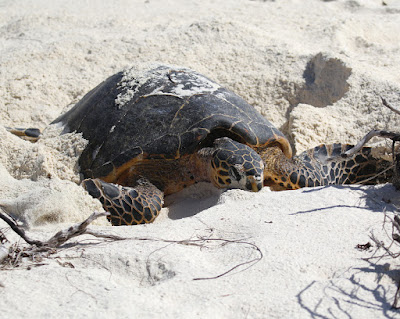 |
| She laboriously fills in the nest chamber after egg laying |
 |
| She makes her way back to the sea |
Hirondelle
By way of variety we decided one day to go out of the back of our chalet and make the ten minute walk to the beach on the eastern side of the island via Hirondelle, which is the name of a smallholding growing vegetables and raising a few pigs and chickens to supply the island restaurant. The other main food source is fish such as Red Snapper and Barracuda caught directly from the surrounding sea. Our favourite waitress in the restaurant, Chennifer lived here with her partner Danny but there was no sign of life as we passed by although we admired the Tree sculpture with shells and coral hanging from it and various other wood workings in front of the house.
 |
| Hirondelle and its decorated tree and assorted driftwood |
 |
| Esmeralda |
 |
| Madagascar Fody - male with less usual yellow plumage |
 |
| Madagascar Fodys- males and females |
 |
| Madagascar Fody - male |
Chennifer had an interesting history being half British half Seychelloise. She had been raised in London and married there, subsequently got divorced and had returned to The Seychelles and now lived with Danny on Bird Island. She had the habit of adding 'innit' as a suffix to many of her utterances which made us all laugh.She also had a passion for Cadburys chocolate, and as she would say, 'Its really good, innit?'
 |
| Selfie with Chennifer |
 |
| Selfie with Mrs U. |
Seychelles Sunbird
As sunbirds go this one hardly sets the pulse racing with colourful iridescent plumage and in fact can be fairly described as drab. The male does have some dark blue iridescent feathering on its chin and breast and sports either a yellow or orange tuft at the bend of its wings that is usually invisible but that is about it. The female is just dark grey and if you do not catch the male at the right angle he appears very much the same. They are however doing very well on Bird Island having been introduced in 2006 and every morning a male was singing loudly right outside our chalet. They feed on the nectar of the many flowering bushes and have the charming habit of calling a short sharp sweeeet as they leave each flower almost as if they are commenting on the quality of the nectar. I found a nest hanging from a bush between two chalets with the female incubating her single egg and on another day watched as a group of them used a water pipe as an impromptu way to have a bath.They are never really still, constantly on the move and the epitomy of nervous high octane energy.
 |
| Seychelles Sunbirds |
 |
| Seychelles Sunbird-male |
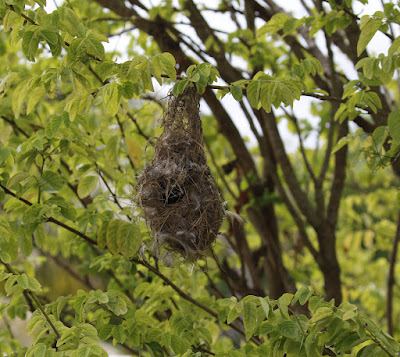 |
| Seychelles Sunbird nest |
Each day passed very much in the same sublime routine of an early morning walk along the sands, birding or looking for turtles, maybe a swim, breakfast and then another swim or just sit on the sand under a palm tree until lunch. Then maybe a siesta for a couple of hours in the heat of the day before another wander around from four onwards as the heat abated. As evening approached we became accustomed to just sit on the beach perhaps with a bottle or two of beer and watch the sun go down. Our favourite spot was at the southern end where we rarely met anyone else and we could look far out over the trackless ocean as the sky turned technicolor and on one memorable evening became really wild, pressaging a spectacular storm of thunder and lightening later that night.
It was never dull and usually a turtle would swim past prospecting the beach, its dark outline clearly visible in the clear shallow water just off the sand's edge. They often put their head up above water and one evening a Hawksbill Turtle actually came ashore twice but then decided better of it and returned to the sea. All the while countless numbers of noddys were coming back from their wanderings out at sea to roost on the island and frigatebirds circled lazily above, spiralling on unmoving outstretched wings awaiting the time to descend for the night into their roosting trees.
 |
| Frigatebirds coming to roost |
Every day was different and every day brought renewed interest and fulfilment. Little things often make a holiday such as this memorable and two things especially stick in my mind. The first was sitting on a sandbank looking down on the azure waters a few feet below me when my wife pointed out a huge black shape moving through the shallow water just a few feet from the shore. It was immense and black with a long tail strung out behind. My wife likened it to a stealth bomber and she was not far wrong as we watched it, the size of a small kitchen table pursuing its sinister, silent and inexorable progress, never wavering from its course. It was a Sting Ray.
On another occasion my wife came back to the chalet to find a Common Myna having a long and noisy sing off with its reflection in the mirror on our dressing table and it was quite unperturbed at my wife's presence so intent was it on seeing off its perceived rival. The chalets are built in an open style to keep them cool with all windows and doors in our case being left open and the roof is raised from the walls so anything can and does wander in.We are fine with this and entertained various rodents and reptiles, said Common Myna and even a couple of errant Brown Noddys that lost their way one night. Velvet Crabs had made their home in small holes by the chalet walls and would be there to greet us each morning sidling furtively though the grass but never straying too far from the security of their holes.
Our fellow guests were an eclectic mix of various nationalities mainly French, British and German and many had been here before. One English couple were on their eighteenth visit. We made friends with a number of British couples who like us were here for more than a couple of days, meeting in the bar before dinner, where we would congregate to mull over the day with a gin and tonic, wine or beer and just chat generally. It was all very laid back and easy going. If you wanted to be sociable fine but if you wanted to just be on your own that was fine also and you could go virtually anywhere and hardly see another soul despite the island being so small. Most visitors had come just for the experience and I would say I was the only 'serious' birder on the island during our stay. There was another English couple with big lenses but they said they were just photographers interested in nature and not really birders.
The food although simple was of a high standard with exotic dishes such as palm heart stew, curried fish in coconut sauce and patal cabbage salad with always a fish or a meat dish available.The heat took away a lot of my appetite which probably was no bad thing and I found myself drinking copious amounts of water to replace the fluids lost by sweating profusely every day. An ice cold beer in the evening was just divine.
One morning I rose extra early at 5am and went to the southern end of the runway to see the Wedge tailed Shearwaters leaving their burrows by the side of the runway. Strange wailing, owl like oooings indicated they were already, in the half light of dawn, heading off for another day at sea and I saw a couple, no more than shapes as they left the land and headed for the ocean. Almost as remarkable were the numbers of Brown Noddys heading out to sea. Lines of them in their hundreds as far as you could see in any direction crossed the surface of the sea all determinedly heading directly away from the island as the dawn rose pink and grey over the sea.










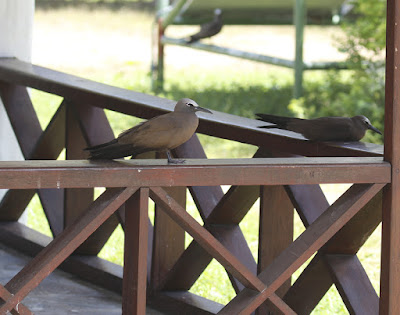







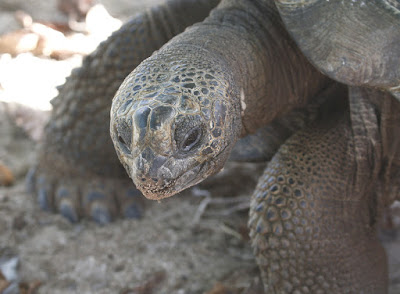



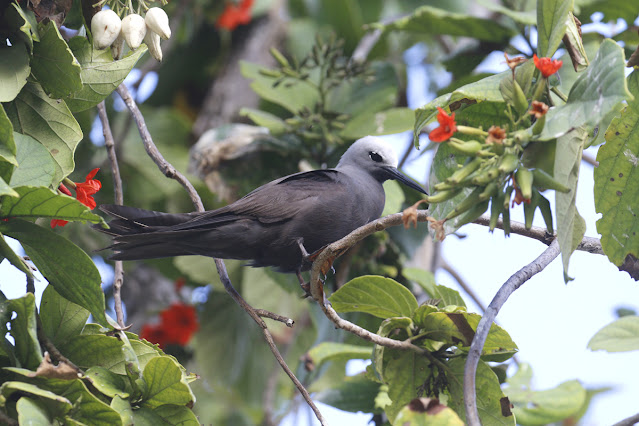

















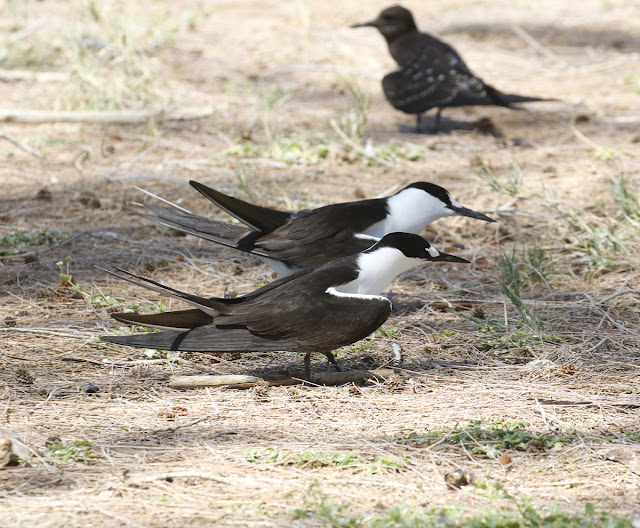



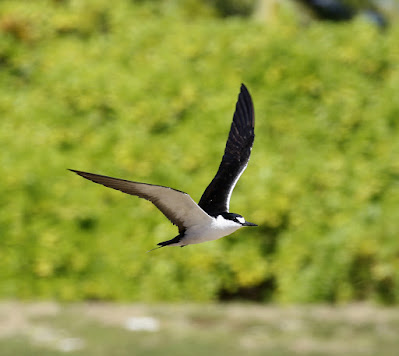
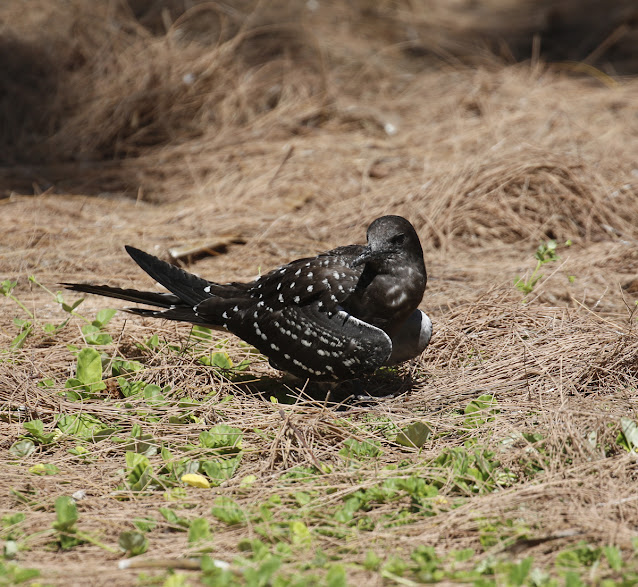














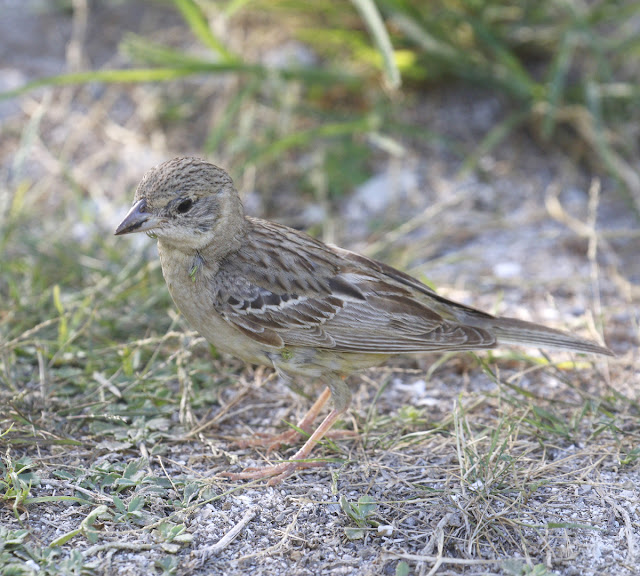














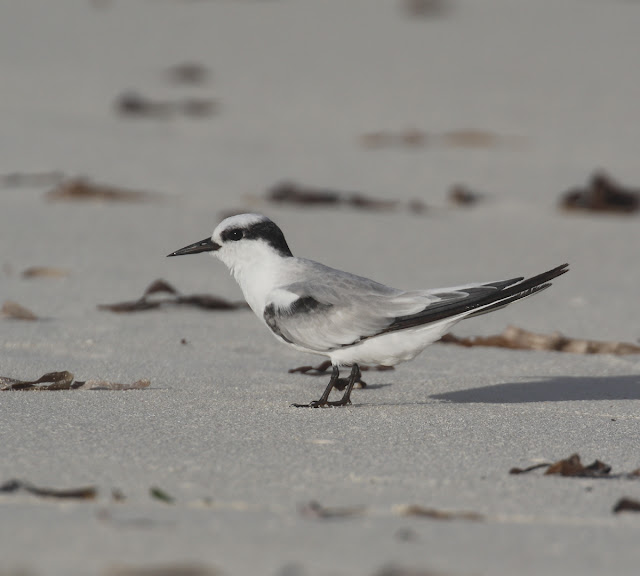






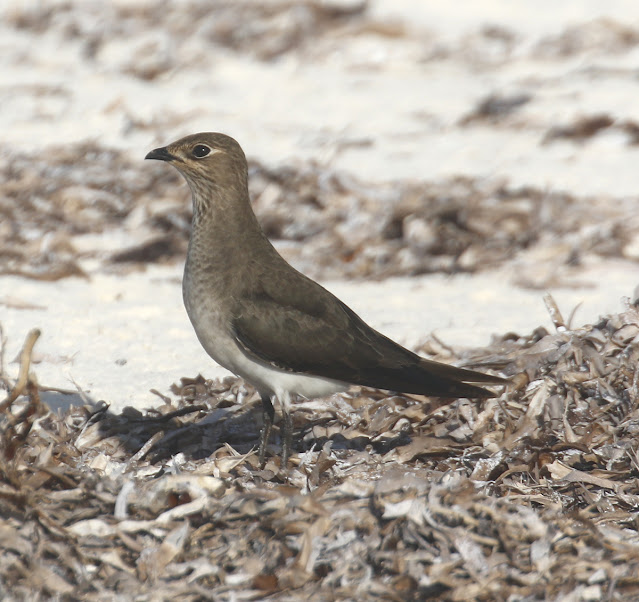































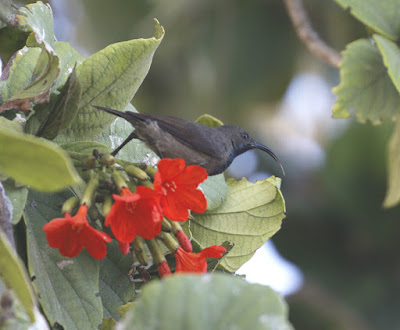










No comments:
Post a Comment